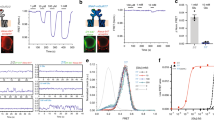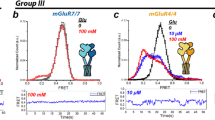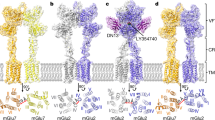Abstract
The metabotropic glutamate receptor, mGluR5, has a critical role in induction of NMDA-receptor-dependent forms of synaptic plasticity and excitotoxicity. This is likely mediated by a reciprocal positive-feedback interaction between these two glutamate receptor subtypes in which activation of mGluR5 potentiates NMDA receptor currents and NMDA receptor activation potentiates mGluR5-mediated responses. We have investigated the mechanism by which NMDA receptor activation modulates mGluR5 function and find evidence that this response is mediated by activation of a protein phosphatase and a resultant dephosphorylation of protein kinase C phosphorylation sites on mGluR5. This form of neuromodulation may be important in a number of normal and pathological processes that involve activation of the NMDA receptor.
This is a preview of subscription content, access via your institution
Access options
Subscribe to this journal
Receive 12 print issues and online access
$209.00 per year
only $17.42 per issue
Buy this article
- Purchase on Springer Link
- Instant access to full article PDF
Prices may be subject to local taxes which are calculated during checkout





Similar content being viewed by others
References
Hollmann, M. & Heinemann, S. Cloned glutamate receptors. Annu. Rev. Neurosci. 17, 31–108 (1994).
McBain, C. J. & Mayer, M. L. N-methyl-D-aspartic acid receptor structure and function. Physiol. Rev. 74, 723–760 (1994).
Conn, P. J. & Pin, J. P. Pharmacology and functions of metabotropic glutamate receptors. Annu. Rev. Pharmacol. Toxicol. 37, 205–237 (1997).
Collingridge, G. L. & Bliss, T. V. P. Memories of NMDA receptors and LTP. Trends Neurosci. 18, 54–56 (1995).
Brodin, L. & Shupliakov, O. Functional diversity of central glutamate synapses—pre- and post-synaptic mechanisms. Acta Physiol. Scand. 150, 1–10 (1994).
Rothman, S. M. & Olney, J. W. Excitotoxicity and the NMDA receptor—still lethal after eight years. Trends Neurosci. 18, 57–58 (1995).
Ciabarra, A. M. et al. Cloning and characterization of chi-1: a developmentally regulated member of a novel class of the ionotropic glutamate receptor family. J. Neurosci. 15, 6498–6508 (1995).
Sucher, N. J. et al. Developmental and regional expression pattern of a novel NMDA receptor-like subunit (NMDAR-L) in the rodent brain. J. Neurosci. 15, 6509–6520 (1995).
Das, S. et al. Increased NMDA current and spine density in mice lacking the NMDA receptor subunit NR3A. Nature 393, 377–381 (1998).
Harvey, J. & Collingridge, G. L. Signal transduction pathways involved in the acute potentiation of NMDA responses by 1S,3R-ACPD in rat hippocampal slices. Br. J. Pharmacol. 109, 1085–1090 (1993).
Aniksztejn, L., Otani, S. & Ben-Ari, Y. Quisqualate metabotropic receptors modulate NMDA currents and facilitate induction of long-term potentiation through protein kinase C. Eur. J. Neurosci. 4, 500–505 (1992).
Fitzjohn, S. M. et al. Activation of group I mGluRs potentiates NMDA responses in rat hippocampal slices. Neurosci. Lett. 203, 211–213 (1996).
Romano, C. et al. Distribution of metabotropic glutamate receptor mGluR5 immunoreactivity in rat brain. J. Comp. Neurol. 355, 455–469 (1995).
Lüthi, A., Gähwiler, B. H. & Gerber, U. Potentiation of a metabotropic glutamatergic response following NMDA receptor activation in rat hippocampus. Pflugers Arch. 427, 197–202 (1994).
Challiss, R. A. J., Mistry, R., Gray, D. W. & Nahorski, S. R. Modulatory effects of NMDA on phosphoinositide responses evoked by the metabotropic glutamate receptor agonist 1S, 3R-ACPD in neonatal rat cerebral cortex. Br. J. Pharmacol. 112, 231–239 (1994).
Lu, Y. M. et al. Mice lacking metabotropic glutamate receptor 5 show impaired learning and reduced CA1 long-term potentiation (LTP) but normal CA3 LTP. J. Neurosci. 17, 5196–5205 (1997).
Collins, D. R., Scollon, J. M., Russell, D. C. & Davies, S. N. Indirect potentiation of synaptic transmission by metabotropic glutamate receptors in the rat hippocampal slice. Brain Res. 684, 165–171 (1995).
Angenstein, F. & Staak, S. Receptor-mediated activation of protein kinase C in hippocampal long-term potentiation: facts, problems and implications. Prog. Neuropsychopharmacol. Biol. Psychiatry 21, 427–454 (1997).
Bortolotto, Z. A. et al. Studies on the role of metabotropic glutamate receptors in long-term potentiation: some methodological considerations. J. Neurosci. Methods 59, 19–24 (1995).
Sacaan, A. I. & Schoepp, D. D. Activation of hippocampal metabotropic excitatory amino acid receptors leads to seizures and neuronal damage. Neurosci. Lett. 139, 77–82 (1992).
Bruno, V. et al. Activation of metabotropic glutamate receptors coupled to inositol phospholipid hydrolysis amplifies NMDA-induced neuronal degeneration in cultured cortical cells. Neuropharmacology 34, 1089–1098 (1995).
Gereau, R. W. & Heinemann, S. F. Role of protein kinase C phosphorylation in rapid desensitization of metabotropic glutamate receptor 5. Neuron 20, 143–151 (1998).
Wang, J. H. & Stelzer, A. Inhibition of phosphatase 2B prevents expression of hippocampal long-term potentiation. Neuroreport 5, 2377–2380 (1994).
Halpain, S., Girault, J. A. & Greengard, P. Activation of NMDA receptors induces dephosphorylation of DAARP-32 in rat striatal slices. Nature 343, 369–372 (1990).
Halpain, S. & Greengard, P. Activation of NMDA receptors induces rapid dephosphorylation of the cytoskeletal protein MAP2. Neuron 5, 237–246 (1990).
Sugiyama, H., Ito, I. & Hirono, C. A new type of glutamate receptor linked to inositol phospholipid metabolism. Nature 325, 531–533 (1987).
Sugiyama, H., Ito, I. & Watanabe, M. Glutamate receptor subtypes may be classified into two major categories: a study of Xenopus oocytes injected with rat brain mRNA. Neuron 3, 129–132 (1989).
Barish, M. E. A transient calcium-dependent chloride current in the immature Xenopus oocyte. J. Physiol. (Lond.) 342, 309–325 (1983).
Palmer, E., Monaghan, D. T. & Cotman, C. W. Glutamate receptors and phosphoinositide metabolism: stimulation via quisqualate receptors is inhibited by N-methyl-D-aspartate receptor activation. Mol. Brain Res. 4, 161–165 (1988).
Morari, M. et al. Excitatory amino acids (EAAs) stimulate phosphatidylinositol turnover in adult rat striatal slices: Interaction between NMDA and EAA metabotropic receptors. Neurochem. Int. 24, 191–200 (1994).
Morari, M. et al. Inhibitory effect of NMDA receptor activation on quisqualate-stimulated phosphatidylinositol turnover in the human cerebral cortex. Brain Res. 553, 14–17 (1991).
Yakel, J. L. Calcineurin regulation of synaptic function: from ion channels to transmitter release and gene transcription. Trends Pharmacol. Sci. 18, 124–133 (1997).
Enan, E. & Matsumura, F. Specific inhibition of calcineurin by type II synthetic pyrethroid insecticides. Biochem. Pharmacol. 43, 1777–1784 (1992).
Doherty, A. J., Palmer, M. J., Henley, J. M., Collingridge, G. L. & Jane, D. E. (RS)-2-chloro-5- hydroxyphenylglycine (CHPG) activates mGlu5, but not mGlu1, receptors expressed in CHO cells and potentiates NMDA responses in the hippocampus. Neuropharmacology 36, 265–267 (1997).
Kawabata, S. et al. Control of calcium oscillations by phosphorylation of metabotropic glutamate receptors. Nature 383, 89–92 (1996).
Mulkey, R. M., Herron, C. E. & Malenka, R. C. An essential role for protein phosphatases in hippocampal long-term depression. Science 261, 1051–1055 (1993).
Mulkey, R. M., Endo, S., Shenolikar, S. & Malenka, R. C. Involvement of a calcineurin/inhibitor-1 phosphatase cascade in hippocampal long-term depression. Nature 369, 486–488 (1994).
Roberson, E. D., English, J. D. & Sweatt, J. D. A biochemist's view of long-term potentiation. Learn. Mem. 3, 1–4 (1996).
Lisman, J. A mechanism for the Hebb and the anti-Hebb processes underlying learning and memory. Proc. Natl. Acad. Sci. USA 86, 9574–9578 (1989).
Acknowledgements
We thank N. F. Ciliax, J. F. Paré, S. Risso Bradley and G. W. Hubert for their technical assistance. We also thank J. P. Pin for supplying the original mGluR5a construct. We would also like to acknowledge Dr. G. Pavlath and Fujisawa USA, Inc. for providing the FK506. This work was supported by NIH NINDS grants (S. A. and P. J. C.).
Author information
Authors and Affiliations
Corresponding author
Rights and permissions
About this article
Cite this article
Alagarsamy, S., Marino, M., Rouse, S. et al. Activation of NMDA receptors reverses desensitization of mGluR5 in native and recombinant systems. Nat Neurosci 2, 234–240 (1999). https://doi.org/10.1038/6338
Received:
Accepted:
Issue Date:
DOI: https://doi.org/10.1038/6338
This article is cited by
-
Maternal stress programs a demasculinization of glutamatergic transmission in stress-related brain regions of aged rats
GeroScience (2022)
-
mGluR5 hypofunction is integral to glutamatergic dysregulation in schizophrenia
Molecular Psychiatry (2020)
-
Social Isolation During Adolescence Induces Anxiety Behaviors and Enhances Firing Activity in BLA Pyramidal Neurons via mGluR5 Upregulation
Molecular Neurobiology (2018)
-
Social deficits in IRSp53 mutant mice improved by NMDAR and mGluR5 suppression
Nature Neuroscience (2015)
-
Novel Glutamatergic Treatments for Severe Mood Disorders
Current Behavioral Neuroscience Reports (2015)



